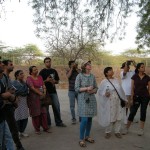Discovering the ruins in Mehrauli Archaeological Park, 11 April 2010
Mehrauli Archaeological Park is one of the most picturesque sites in Delhi. The area is virtually littered with ruins. Besides the prominent tombs and mosques there are numerous unnamed ruins which were probably part of residential settlements. Crumbling walls and niches are peek out from the surrounding vegetation. Balban’s tomb is the first major monument on the heritage walk. It is an extremely significant building as it is the earliest surviving example of the use of the true arch in construction. The adjacent chamber has a grave which is traditionally believed to be of Balban’s favourite son, Khan Shaheed. Immediately after the tomb is a large area covered with ruins of small rooms which may have been residential units. Only the foundations remain now and we can see that some of these structures might have been double-storeyed. A little ahead is the Jamali Kamali mosque and tomb. This is the monument which gives the area its local name. This is a protected monument under ASI and is now always under lock and key. This is because some local Muslim groups in the neighbourhood tried to reclaim historic mosques in the area and restarted offering prayers. The ASI does not permit revival of religious practices in monuments which were not in use when brought under protection. The dispute remains an unresolved one and so access to this monument is restricted. The area north of Jamali Kamali mosque was purchased in the 19th century by the then British resident, Thomas Metcalfe. Metcalfe re-landscaped the area which still has follies put up by him to beautify the terrain. And there is more…he diverted a stream, built a carriageway over it for his buggy, converted a dove court into boathouse and modified a Mughal tomb into his residence!! Metcalfe called this place ‘Dilkhusha’ or ‘the delighter of the heart’! We climbed the roof to his Dilkhusha which has an excellent view to the surrounding area. The next stop was Rajon ki baoli, a beautiful stepwell which seems to be in the middle of nowhere. Being underground, the baoli reveals itself very gradually to the approaching visitor. One only sees the topmost storey standing at the entrance to the complex and as one walks towards the steps to the baoli, the succeeding storeys reveal themselves one after the other, making it a delightful sight to behold! The last stop on the heritage trail was canopy believed to have been built as burial place for Khan Shaheed.
(posted by Rajesh Ranjan & Kanika Singh, team members, Delhi Heritage Walks)







